|
Some licensing research I did. It's a bit dated, but still relevant.
Top Ten Licensors for Children (First number is overall licensor in all categories) #7 Sanrio (U.S. includes Hello Kitty, My Melody, Chococat, Keroppi, BadtzMaru etc.) 1,047,399 facebook likes 89,700 twitter followers 10,199 pinterest followers 34,076 youtube subscribers 107 videos 397,000 instagram followers #12 Rainbow (Winx Club t.v. show) – (very heavily user generated accounts) User generated facebook pages – none with more than 1,500 followers 1,151,991 facebook likes 7,451 twitter followers for Winx Club All – official fans club pinterest – all user generated 572,367 youtube subscribers for Winx Club English 43,900 instagram instagram #29 Pokeman 7,513,406 facebook likes 4,570,000 twitter followers UGC on pinterest 2,279,368 youtube subscribers 1,400,000 instagram followers #46 Sesame Street 1,000,000 facebook likes 1,910,000 twitter followers 7,140 pinterest followers 3,067,360 youtube subscribers 157,000 instagram followers #49 Entertainment One – Peppa Pig 2,800,000 facebook likes 35,900 twitter followers UGC for pinterest 2,834,198 youtube subscribers 12,000 followers on “the officialpeppa instagram. Much UGC #57 Dr. Suess 2,200,000 facebook likes 1,749 twitter followers no pinterest 589 youtube subcribers (a lot of UGC) UGC for instagram #58 Saban – Power Rangers 2,800,000 facebook likes 110,000 twitter followers UGC pinterest 375,058 youtube subscribers 220,000 instagram followers #62 Lego 12,000,000 facebook likes 492,000 twitter followers 72,365 pinterest followers 3,922,410 youtube followers 2,300,000 instagram followers #65 Freemantle Kids – Danger Mouse 118,000 facebook likes 5,912 twitter followers UGC pinterest 8,353 youtube subscribers UGC instagram #71 DHX Media – In the Night Garden 186,000 facebook likes 5,930 twitter followers 224 pinterest followers UGC instagram Top Ten Preschool T.V. Shows (ThoughtCo) 1.The Backyardigans – Nickeldeon 2.Super Why – PBS Kids 3.Bubble Guppies – Nickeldeon 4.Team Umizoomi – Nickelodeon 5.Dora the Explorer – Nickelodeon 6.Between the Lions – PBS Kids 7.Sesame Street – PBS Kids 8.Imagination Movers – Disney 9.The Little Einsteins – Disney 10.Sid the Science Kid – PBS Kids 10 Best Netflix Shows for Preschoolers 1.Super Why 2.Little Einsteins 3.Sarah and Duck 4.Pocoyo 5.Kazoops 6.Luna Petunia 7.Word Party 8.Ask The Storybots 9.Puffin Rock 10.Justin Time 6 Top Youtube Channels (5 of the top 6 top Youtube channels are for kids) 1.Funtoys Collector, U.S. based toy unboxing channel – 477.5 million views/month 2.Little Baby Bum, British nursery rhymes channel – 385.1 million views/month 3.Masha and the Bear, Russian cartoon channel – 323.1 million views/month 4.Get Movies, Russian cartoon channel – 311.2 million views/month 5.Taylor Swift 6.The Diamond Minecart or TDM, British gamer (minecraft) videos, 298 million/month Categories of Youtube Shows for Children: Songs/music videos – Lullaby Baby, 130,000 subscribers, LittleBabyBum, 13,496,560 subscribers, Finger Family, 13,000,000 subscribers (Bollywood music is very upbeat if not annoying) Cartoons – Sesame Street, 3,000,000 subscribers, Masha and the Bear, 12,000,000 subscribers Gamers – TDM, 16 million subscribers Unboxing – Faces seen or not, Surprise Eggs, 9,600,000 million subscribers ToyBoxCollectibles, 593,352 subscribers Play acting with toys, Faces or not, with or without music/dialogue – Mashup of Thomas the Tank Engine and Spider-Man on a Hot Wheels track Educational - Alphablocks, Book reading – Speakaboos, 33,000 subscribers Crafts/DIY – Faces seen or not seen, DIY My Pretty Pony (Crossover with Play acting) Science experiments (older kids) The Backyard Scientist, 3,100,000 subscribers, Crazy Russian Hacker, 10,000,000 subscribers Best Science Shows for Kids from Stay at Home Science 1.Wild Kratts a.Channel: PBS b.Subject Matter: Animals and Nature c.STEM Skills Taught: Animal characteristics, behavior and relationships; Caring for the Environment; Vocabulary building; World geography d.Summary of the Show: The 2 main characters, the Kratt brothers, are scientists who love to explore nature and learn about new animals. With the help of their team (which includes two very smart women of color and one very dumb white guy), they obtain morphing ‘Creature Power Suits’ that give them the ‘powers’ of a specific animal. e.Watchability for Parents: I really like this show. They use footage of real animals at the beginning and end of each episode, and I always feel like I’ve learning something new every time I watch it! The villains are cliche and slightly annoying, but they don’t usually get in the way of the storyline. And who can say they’ve never dreamed of having animal powers before?? f.Best for ages 3 and up 2.Sesame Street a.Channel: PBS and HBO b.Subject Matter: General Science and Math c.STEM Skills Taught: Numbers and counting; Shapes and patterns; Making observations; Collecting data; Vocabulary building d.Summary of the Show: Come on, unless you’ve been living under a rock, you know what Sesame Street is about. Depending on the episode, you’ll learn about spiders or camouflage or triangles. There is always a “Number of the Day” introduced by The Count, and characters are often using shape or pattern recognition to solve a problem. e.Watchability for parents: Sometimes the stories are funny (Cookie Monster is always doing some HBO series parody), and every now and then, you may get to see your celebrity crush hanging with Elmo. Enough said. f.Best for ages 1-5 3.Nature Cat a.Channel: PBS b.Subject Matter: Nature and Environment c.STEM Skills Taught: Animal and plant characteristics and relationships; Habitats; Caring for the environment; Making Observations; Forming and testing a hypothesis d.Summary of the Show: Nature Cat and his backyard pals are all suburban pets with a double life (after catching many clues, I’m convinced they live outside of Chicago, my hometown). When their owners are away, they go on adventures through the outdoors, hanging out with all kinds of wild animals and caring for the environment. e.Watchability for parents: I’ll admit it, I get riveted when this show is on! I think it’s really clever, and I love the push for environmental stewardship. At the end of every episode there is a ‘commercial’ for a natural item as a toy (“Pile of dead leaves! Every kids should have one!”), which is incredibly amusing to me. f.Best for ages 3 and up 4.Team Umizoomi a.Channel: Nickelodeon/Nick JR b.Subject Matter: Math c.STEM Skills Taught: Numbers and counting; Shapes and patterns; Estimating; Making observations d.Summary of Show: Three tiny, odd characters (Gio, Milli, and Bot…a.k.a. Team Umizoomi) help some non-animated kid solve a problem in each episode. They use all kinds of early math skills to get them past obstacles. e.Watchability for parents: My kids love it; I am not totally annoyed by it. f.Best for ages 2-5 5.Go, Diego, Go! a.Channel: Nickelodeon/Nick JR b.Subject Matter: Animals and Scientific Method c.STEM Skills Taught: Animal characteristics, behavior and relationships; Using tools; Gathering data d.Summary of Show: Diego is Dora the Explorer’s cousin. He and his friends go on missions through the jungle (much like his cousin before him) to help animals in trouble. e.Watchability for parents: My 2-year-old daughter really likes Dora and Diego. The best part about watching this show is watching her giggle, point, clap and try to answer questions. f.Best for kids ages 1-4 6.Dinosaur Train a.Channel: PBS b.Subject Matter: Dinosaurs c.STEM Skills Taught: Dinosaur vocabulary; Dinosaur characteristics and habitats; Forming and testing a hypothesis d.Summary of Show: A family of Pteranodons (with an adopted T-Rex son) travel around the world and through time on the Dinosaur Train, led by a Troodon called ‘The Conductor.’ They meet and befriend all kinds of dinosaurs, pterosaurs and sea creatures. In this ‘kumbaya’ prehistoric world, none of the dinosaurs eat each other…which is nice, but slightly inaccurate. e.Watchability for parents: If you are a dinosaur geek at heart, it’s mildly entertaining at first. But perhaps the real draw of the dinosaur world is the ferocity of a snarling Tyrannosaur, so a dinosaur utopia gets kind of boring after a while. f.Best for ages 1-4 7.Doc McStuffins a.Channel: Disney Junior b.Subject Matter: Medicine and Anatomy c.STEM Skills Taught: Forming and testing hypothesis; Personal care and safety d.Summary of Show: Doc McStuffins is a young girl with a magic stethoscope that brings toys to life. She and her stuffed animal medical team spend their days fixing broken and ailing toys of all types. e.Watchability for parents: I really like the clever premise of this show (probably because when I was little I would have given my right arm for a magic stethoscope that brought my stuffed animals to life). I watched it with my kids quite often… until I found myself singing “Time for a Check-up” in my sleep. (If you don’t know this tune, Google it. You can thank me later.) f.Best for ages 2-5 8.Octonauts a.Channel: Disney Junior b.Subject Matter: Ocean Life c.STEM Skills Taught: Ocean animal characteristics, behavior, relationships; Gathering data; Using tools d.Summary of Show: A motley group of octonauts (Are they animals, cats, vegetables…? I don’t really know, but they strangely lack facial features) cruise around the ocean going on adventures and helping sea creatures in need. At the end of each show, they do a “Creature Report” to summarize what they have learned about the animal of the day. e.Watchability for parents: I don’t know what these Octonaut things are or why one of them is a turnip. This is all I can think about every time I watch this show. But my kids like it, and the theme song is forgettable (which actually counts for a lot… see Doc McStuffins). f.Best for ages 2-5 9.Blaze and the Monster Machines a.Channel: Nickelodeon/Nick JR b.Subject Matter: Engineering and Math c.STEM Skills Taught: Numbers and counting; Estimating; Making observations; Using tools; Engineering vocabulary building d.Summary of Show: Blaze is a talking monster truck who, along with his driver AJ and other monster truck friends, is always in some kind of race. He has to transform into different machines to conquer the obstacles in his way. The ‘bad guy’ (a blue monster truck named Crusher) is not so much bad as misguided, and slightly desperate. Crusher somehow has the ability to whip up some unbelievable apparatus to slow Blaze down during every show (for example, he made a machine that alternatively spits out chocolate and cheese balls…which you would think would make him a millionaire who never had to race again). So he clearly isn’t living up to his full potential. e.Watchability for parents: I have a 4-year-old son, so I have seen every episode of Blaze 900 times. There are a billion things about this show that drive me crazy. Yet my son relates a lot of real life stuff he sees back to things he learned on Blaze. So I tolerate it. Like people who live next to a loud, droning highway, I have absorbed the background sound of Blaze and the Monster Machines as part of my very existence. f.Best for ages 1-4 10.Ready Jet Go! a.Channel: PBS b.Subject Matter: Space Science c.STEM Skills Taught: Gathering data; Planet characteristics; Making comparisons; Space vocabulary building d.Summary of Show: Jet Propulsion, the main character, has just moved with his family to Earth from a far-off planet in a distant solar system. But his house can still turn into a spaceship, so he and his new Earth friends spend their free time perusing outer space and learning about the planets. e.Watchability for parents: I love everything Space, but I must admit that I find this Jet kid a bit irritating. He is perpetually happy…but not in a cute, Mickey Mouse way. Rather in a bounce-around-the-room, waving jazz-hands, singing show tunes, kind of way. I want to flick him. But that being said, there aren’t that many educational space shows for preschool-age kids, so we watch it and talk about planets… but just once a week. f.Best for ages 3 and up
0 Comments
Does subsidizing grocery stores for Food Deserts work? The availability of fresh food depends a whole lot on where you live. What if you live in an economically disadvantaged neighborhood? Your neighborhood grocery store moonlights as a liquor store with nary a vegetable in sight? You don’t have a car, and can’t (obviously) carry more than a couple bags on a bus to get home from a store three neighborhoods over. Do you have access to fresh fruit and vegetables and nutritious food?
What if you can’t risk your very small grocery budget on produce that spoils much more quickly than prepackaged food? Or risk it on kids who won’t eat the vegetables you buy anyway? What then? Who can blame you for not eating healthier? I’ve never been poor. There was that time after my divorce with a 2 and a 5 year old where I considered myself poor, but I wasn’t. I never wanted for food. In the United States, over 15 percent of Americans live in poverty. As a single parent with two children, you are considered poor if your annual income is $21,720 a year, or less. I was making nearly four times that back when I got divorced and was a business executive working in Los Angeles. I can tell you that I struggled to make ends meet. And I’m frugal! But L.A. is an expensive city to live in and after rent, utilities, car payment and child care, there were many weeks when I put the groceries on a credit card. At least I had a credit card. Compounding the cost challenge, many people don’t have easy access to fresh, healthy and nutritious food. These areas, usually lower income urban or rural areas, are called Food Deserts. This is defined as a geographic area where affordable and healthy food is difficult to obtain, particularly for those without access to an automobile. Food Deserts British politicians introduced the idea of Food Deserts in the 1990s, adopting the term after a few preliminary studies suggested a link might exist between distance to a grocery store and the diets of poor people. The concept had caught on in the U.S. by 2004, when Pennsylvania passed a Fresh Food Financing Initiative. It offered grants and loans to supermarkets willing to open in distressed neighborhoods and helped smaller stores expand their supplies of fresh food. Twenty-two states now have some version of fresh-food financing and there are countless local and nonprofit programs, including cooking and nutrition classes designed to get more fresh fruits and vegetables into the lives of poor people. But recent research has shown that this approach has not helped. The alarming obesity rates among low income individuals, families and children hasn’t budged in the Food Deserts where grocery stores have opened. Many studies have shown no significant impact between the food environment and diet. The Fresh Food Financing programs have pretty much failed. Comments on an article in a Slate Magazine article about these findings are so typical. You have the progressives chiming in about the stress of poverty being the factor most affecting health of poor people. They argue for increasing the minimum wage and expanding food stamp programs. The conservatives counter that poor people should, “just get a job,” and it is more about their choices to eat junk food over healthy food rather than the availability of fruit and vegetables. Mostly they complained about giving out food stamps at all. One reader commented: “You can lead a poor, obese, diabetic to broccoli but you can’t make him eat it.” Well, that’s true, isn’t it? I think all these things are true. Poverty is stressful in and of itself. I discovered that in my quasi-poverty-stricken phase of life. We should increase the minimum wage. People should have jobs. Food stamps do help and should be increased. And yes, it is probably more about choices than anything else. So to me, the question we should focus on is: How do we get poor, overweight people to choose to eat vegetables? In a Psychology Today article, Edward Abramson, Ph.D. explains, “Some sour or bitter substances are poisonous or inedible but very few sweet tasting things are. Hundreds of thousands of years ago our prehistoric ancestors who ate sour or bitter things were more likely to perish; those who ate only sweet things were more likely to survive. Liking sweet tastes was a survival mechanism that has been passed down to us.“ So it is in our genes! How do we overcome this? There are a lot of creative things that can be done such as repetition, starting with sweeter vegetables, and sprinkling grated cheese or other toppings on them. (I happen to think less is more when it comes to preparing vegetable dishes.) From my experience, healthy eating habits should start in preschool and elementary school. Not that older kids and adults can’t learn to eat healthier, but it’s just a lot harder. I am the CEO of a company that sells and donates hands-on gardening programs to preschools across the country. What we have found in our experience with thousands of children is: teaching a child it is healthy to eat vegetables does not mean they will eat them. Even bringing in a celebrity chef to cook the tastiest vegetable dish imaginable would not encourage kids to eat vegetables (as a parent to 4, I can vouch for that). However, when children grow their own vegetables, almost 100% of the participants will eat them. We have proven this over and over. However, it is difficult for us to get schools — that are always overworked, under budgeted and teaching to standardized tests — to even schedule a meeting with us. I look at this as part of the culture of our country to focus on a problem after it has happened instead of focusing on measures to prevent it from happening. Yes, the school garden approach might take a generation before the positive effects would be realized, but we’ve got to start somewhere. I think subsidizing school gardens and more importantly inserting that into curriculums (so the teachers can take the time to do it), would be money better spent than giving subsidies to open grocery stores in poor neighborhoods. Because ultimately, what good is a grocery store selling fresh vegetables if kids aren’t willing to eat those vegetables? Or if grownups never developed a taste for them? Let’s start with getting young children to develop a taste for eating healthier — then — subsidize the grocery stores to sell healthy food. Although well-intentioned, I believe that the United States government’s idea of subsidizing grocery stores is a matter of putting the cart before the horse. In order to get schools and school districts behind school gardening programs, the parents have to put pressure on them. Should enough parents get together and pressure their school district, change will happen. One of my favorite books in recent years is called Influencer: The New Science of Leading Change. In it they talk about how just a couple small steps can lead to lasting and meaningful change. I think people look at a seemingly intractable problem like obesity and think they need to enact major policy changes that are almost impossible to achieve. Instead, I ask, why not mandate school gardening for young children as a first step? In my opinion, it should be as important as learning to read and write. For readers that are passionate on this subject, please visit my website: CynthiaWylie.com. Join our community on Facebook, Bloomers Island, to engage with us. I have written a five-book series, Bloomers Island about gardening with kids published by Rodale Kids, an imprint of Penguin Random House. See you in the garden! Let’s Choose Our Seeds
Spring is just around the corner so it’s time to decide what vegetables and fruits you would like to grow. Go with your parents to a place where seeds are sold, or look for them together in an online store. Help the grownup in your life pick out the seeds you would like to grow. Here are some ideas that might help you. What are your favorite dishes? Do you like French fries dipped in ketchup? Then you should try growing potatoes and tomatoes. French fries are made from potatoes, and ketchup is made from tomatoes. Are carrots your favorite vegetable? How about watermelon? Or maybe you can grow a pumpkin to carve for Halloween. The bloomers have favorite vegetables too. Big Red wants to grow tomatoes because ketchup is his favorite food in the whole wide world. Big Red likes ketchup so much that he puts it on everything, even his ice cream! I know. Ewwwww. Rosey Posey grows radishes because they are pink just like her. And who doesn’t like pink? Also, radishes grow quickly so she doesn’t have to wait very long to harvest them and make her favorite pink cheesy dip. Pete Moss chooses spinach because he wants to grow stronger and spinach is loaded with vitamins that will help you grow stronger. He was embarrassed when his friend Basil beat him at an arm-wrestling contest so he wants bigger muscles. Violet loves eggplants because they are violet just like her. Her favorite dish is parmesan eggplant fries. And with the leftovers, she makes eggplant sandwiches. Yum. Basil grows cucumbers because his favorite dish is cucumber and cream cheese sandwiches with the crust trimmed off the bread, of course. Lilly wants to grow pumpkins because she read a story about a girl whose fairy godmother turns a pumpkin into a magical carriage. She wants to make her own magical carriage. And besides, she loves pumpkin pie. Bud Inski grows lean green beans because they are tall and thin and he wants to grow tall and thin like a bean. He also likes to mix his beans with creamy soup, almonds and breadcrumbs. That’s called a green bean casserole, and it’s really tasty. Daisy chooses yellow squash which is also called summer squash. The cool thing about yellow squash is that you can eat it raw or cooked. That means she doesn’t have to cook if she doesn’t feel like it. And the best part is, you can eat the beautiful yellow flowers. What about you? What vegetables or fruits would you like to grow and eat? As I prepared to get ready for bed a few nights ago, a whimsical thought occurred to me that it would be nice to write for Forbes Magazine. Early the following morning, a fuzzy dream settled over the balance of my sleep. I awoke to the dream that I was actually a contributing writer for Forbes. Was that a coincidence?
For a long time, I’ve known that thinking and writing down something before you go to sleep will seep into your subconscious and you may dream about it and even manifest it. The seminal book on this subject in particular is “The Power of Your Subconscious Mind,” by Dr. Joseph Murphy who writes about this exact thing. “You can bring into your life more power, more wealth, more health, more happiness, and more joy by learning to contact and release the hidden power of your subconscious mind. You need not acquire this power; you already possess it. But, you want to learn how to use it; you want to understand it so that you can apply it in all departments of your life.” As an example, Dr. Murphy states that if you want more wealth, just repeat quietly to yourself as you fall asleep, “wealth.” Say it quietly, and say it over and over. If you want to write for Forbes, imagine this scenario in your mind as you drift off to sleep. I once took this advice to heart and wrote a large number on a piece of paper. That was the amount I wanted to make by selling the company where I was a partner at the time. Shortly thereafter, my partners and I received an offer for the company. It was a solid offer. My partner wanted to accept it, but it was only half of the number that I had written down only several months before. I held my breath and told my partner to respond to the offer by doubling it. Yes, doubling it. He said that he would do so. He did it right then and there by contacting the prospective buyer via email. We were prepared to wait, as the offer came from a time zone that was 16 hours ahead. Almost immediately, we got a reply with a, “Yes.” It took some time, but the deal closed and we received exactly the number written down on that piece of paper. I still have it. The name of this technique is called the Power of Suggestion. Hypnosis works using this same concept. Recently, I thought, what if we applied this to our children? What if we gave our children a suggestion as they were drifting off to sleep. What if we just said simply and quietly, “You are powerful.” Because children often feel powerless. To imbue them with the suggestion of power would be so, well, powerful for them. When he was young. my son had developed a skin condition on his hands. It was growing and spreading. We tried everything. We put medicine on it, night after night and nothing was working. A friend had just received his certificate in hypnosis. I asked him if he could hypnotize my son to make the condition go away. He told me that hypnosis would work really well for just this thing, but unfortunately, my son was probably too young and too hyperactive for it to work properly and have a successful outcome. He suggested that he write down a hypnotic suggestion and that I read it to him when he was in the sleep stage 1, non-REM, transition between wakefulness and sleep, which lasts about five to ten minutes. I did exactly that and within one week his condition was healed. It completely disappeared. Do kids feel powerless today? According to Kid’s Help Phone, kids start to feel powerless when the pressures in their lives build. This can be a result of anything from academic pressures, to social anxiety, to over scheduling by parents. In today’s pandemic, those feelings of powerlessness are magnified and not just for kids. Parents experience the same burdens. One of their suggestions is to help children achieve small successes and work from there. You can empower them by letting them make their own choices. You can also help them breakdown exactly what it is they are worried about. Tonight, I'm starting to say, "Health" to myself while going to sleep. Try using the power of suggestion for both your children and yourself. Let me know how it goes. Growing up on a farm, of course involved quite a bit of heavy manual labor without paychecks and vacations. I didn't receive any allowance or payment for my work on our farm. I think my parents looked at it as pro bono work, which means literally: for the good of, and in this case, for the good of the family, our family. But what both of my parents missed is that there was a quid pro quo involved - an exchange of one thing for another thing of value. I have three brothers, and we were all quite young when we moved to our first farm. I remember well the day my mom gave me a choice: you can do housework or barnwork, but you have to work. Well of course I chose the barn work. My mom was so cool. Still is. I loved taking care of the animals every morning and night, feeding and watering, brushing the horses, collecting the eggs, sweeping the long barn aisle, cleaning the stalls and spreading fresh sawdust. It was difficult. The bales of hay and straw were heavy. In the winter, the pipes froze and we had to carry all the water by hand in five gallon buckets. Pouring the grain into the wheelbarrow required deadlifting one hundred pound burlap sacks of oats and corn. All of this had to be done morning and night, freezing and sweltering weather, school days and weekends, summer vacation, holidays, seven days a week, 365 days a year. We didn’t take vacations. It’s one thing to have someone dog sit for you when you go to the beach, and another to ask someone to take care of a menagerie of horses, goats, chickens, hogs, cows and even a few ducks. Our vacation was the Butler Country Fair, one summer week a year where we camped out and showed our horses and drove home everyday to take care of the animals. I credit it for the work ethic that I hold to this day. In this scenario, I was getting a quid pro quo. I was able to be outside in the fresh air, taking care of animals, letting my imagination run wild with ideas and stories and interacting with nature. It also engendered the feeling of a job well done – the stalls were clean, the aisle well-swept, the animals fed and watered. I have a firm belief that parents should never underestimate the power of using a quid pro quo with their children. It can be simple, “If you stop whining, I’ll give you a cookie.” Or it can be deeper and healthier: a sense of accomplishment, learning something important, putting newfound skills to use. When I wrote my first published book, Bloomers Island, I wanted to incorporate this concept. I made the moral of the story, everything is more fun when it’s a party. That’s why I called it, “The Great Garden Party.” Maybe it was my inner Mary Poppins. It was one of the few movies I saw as a child, because the closest movie theater at that time was all the way in the North Hills of Pittsburgh. What a great movie Mary Poppins was! I loved that she made cleaning the room fun for Jane and Michael Banks. A spoonful of sugar makes the medicine go down after all. If you clean your room we will use magic and have fun. I still remember the lyrics: In every job that must be done there is an element of fun You find the fun and snap! The job's a game And every task you undertake, becomes a piece of cake A lark! A spree! It's very clear to see that A Spoonful of sugar helps the medicine go down The medicine go down-wown The medicine go down Just a spoonful of sugar helps the medicine go down In a most delightful way There was no payment nor were there prizes involved or rewards. It was just finding the fun and the sense of accomplishment in a job well done. Many of the Bloomers, little plant, flower and tree sprouts, weren’t that enthused about gardening. Rosey Posey thought that it seemed like too much work. And Basil confided that he didn’t like getting his hands dirty. So Professor Sage, in all of his sage wisdom, decided to make the act of gardening a game. He sneakily constructed a series of contests, each one an important element of learning to grow food, so that the Bloomers learn to garden, without even realizing it. He gave them a quid pro quo - which was learning something important and a sense of accomplishment. Whenever I perform school author events, I tell my audience that this is the moral of the story and I tell them to tell their parents. Mark Twain was a genius at this. He figured out how his fictional character, Tom Sawyer, could get his friends to help him with his punishment of whitewashing the fence. His friend, Ben Rogers commented about Tom’s work. Tom simply asked, “What work?” He pretended like it was fun. And when Ben wanted to join in, Tom wouldn’t let him at first. Finally, Ben gave him an apple to let him paint the fence. That’s what you can do with your kids. Make it fun. Figure out how you can do that. Be creative, and that in and of itself will be fun for you.  Photo Credit: Nicole Dusseljee @anothernicole Photo Credit: Nicole Dusseljee @anothernicole You want your kids to clean their room? Time them and give them a prize if they can do a series of tasks in an allotted amount of time. Do your homework early? We can watch that movie you wanted to see. Do your laundry? Yes, even young children are capable of sorting, stuffing it in the washing machine, adding a cup of soap, then the dryer, and folding their own laundry. Quid pro quo: your clothes smell as sweet as a flower. Pull weeds in the garden? Quid pro quo: I’ll let you help harvest the fruit and vegetables. Eat their vegetables? I’ll allow you to pick out a fun recipe and cook it together. Figure out what they want to do. Ask them what they like doing: housework or barnwork, or yard work, or garden work. If they’re doing something they like, it won’t feel like a chore. Of course, when doing your own work, you may want to keep this in mind yourself, and in a most delightful way. As many of you have read, I grew up on a farm. Maybe it’s the power of nostalgia, but I’ve described my childhood as pretty idyllic and I believe that it was. I actually felt guilty that I raised four children in a big city like Los Angeles where they didn’t have the freedom to be outside playing all day, swimming in the creek, riding ponies, or catching fireflies.
As wonderful as I felt my childhood was, though, life on a farm is dangerous. Farming has the third highest accident rating of all professions — surpassed only by mining and construction. On our street alone, a neighbor boy lost his arm in a posthole augur (digger) and the farmer on the other side of us, a woman, lost two fingers in the grain elevator. My best friend in the first grade fell off her pony (before we used to wear helmets) and died instantly when her head hit a rock. Her father promptly took his shotgun out to the barn and shot the pony — a tragedy all the way around. Childhood can be dangerous everywhere, and as a parent, it felt like I was always scrambling to protect my children and make sure they were safe, without keeping them cooped up and under foot all day. To be sure, living in a big city had its own form of lurking dangers. I worried about any crazy, creeper that I never had to deal with living in the country. Every few months I would check the Sex Offender Registry. I gave them all whistles to wear around their necks with the instructions to blow the whistle if anyone bothered them. I gave them tips about only walking down the side of the street that goes against traffic, because anyone trying to steal them would have to do a U-Turn which would make it much more difficult. I told them to fight and scream because abductors are less likely to take a child if they are making a big fuss. They want it to be easy. They will just move to the next kid. Yes, I researched all of this. Speaking of stealing kids, my worst nightmare was just that. One time my toddler son got lost at the mall (he was playing the newly discovered game of hide ‘n seek). I was in a complete panic and when we finally found him, well, let’s just say that he was pretty much scarred from ever playing hide ‘n seek again. Tip: don’t ever read, The Silence of the Lambs. It’s probably to their benefit that my children weren’t as concerned about these issues as I was. Nevertheless, I had a job to do! I was protector in chief!! After the umpteenth time yelling at them to quit doing this or stop doing that, I happened upon an idea. I would tell them a story as to why they shouldn’t run at the swimming pool. I created a character that had encountered every imaginable accident while not taking the precautionary measures that I wanted my kids to take. I used the name of an old friend of mine, and Nancy Gump, the unluckiest girl in the world, was born. “Don’t run around the swimming pool. I had a friend, Nancy Gump, who did that and she fell and hit her head and went deaf in one ear.” “Don’t run with a stick in your mouth! I had a friend, Nancy Gump, who did that and the stick poked right through the top of her mouth and then she could only eat vegetable soup for the rest of her life.” (Do you like the vegetable soup touch? Yes, sadly, most kids don’t like vegetable soup.) “Be careful with that saw! My friend, Nancy Gump, sawed clear through her leg doing that.” “Don’t sleep with a rubber band around your finger. Nancy Gump did that and her finger turned black and fell off.” You get the point. Even though it was gross, it worked really well. I’m proud to announce that all my children have all their limbs, senses and digits. And the best part is, I didn’t have to be the nagging mom all the time. One Nancy Gump story and the rule was established. But the real power behind my method was the stories. Stories are immensely effective with everything from public speaking, to sales, to convincing children to listen to you. In, How to Use Stories to Win Over Others, Jennifer Aaker, Professor of Marketing at the Stanford Graduate School of Business, says there are four characteristics of an effective story: 1. Goal — Why are you telling the story? To protect my children. 2. Grab Attention — Why would the audience what to listen? Cutting off your leg is definitely an attention grabber. 3. Engage — Why would the audience care? Because they love their leg. 4. Enable Action — Why would the audience want to share the story? So all their siblings and friends can save their leg too. Aaker states that we should all have a signature story. She goes further by saying that we need a portfolio of stories for different goals and different audiences. Here’s the really cool thing. If you’re trying to convince someone to do something, sharing a story with them is forty times more effective than giving them data or statistics. And combining the two is even more effective. According to Horst Kornberger in his book, The Power of Stories: Nurturing Children’s Imagination and Consciousness, he states, “From the great myths and legends to enchanting fairy tales, parables, fables and folktales, stories can have a great healing and educative power. They come from our subconscious and imagination, deep inside us. They have much to teach us about ourselves, therefore, and the world we create around us.” When my daughter was in Preschool, she sat down one morning and wrote the story (phonetically), “The Bare and the Hare.” It was about a little girl going into the forest and finding a “Bare,” who she was terrified of and after being helped by the Hare, she realized that it was only her little sister. (Her dad and his new wife were having a baby girl.) A couple years into the Nancy Gump stories, I reconnected with her and set up a visit for the next time we went back to the family farm. When we knocked on her door, my kids were petrified, imagining a woman without arms and legs, eyes and ears. Out came Nancy Gump, intact and giving out kisses and hugs and presents, and my kids were dumbfounded. They knowingly looked at me. I smiled. The jig was up. But they were already past the age of reckless behavior. I had protected them. Mission accomplished. Photo Credit: Dennis P. Kamoen “When your child enters the room, does your face light up?” ~ Toni Morrison Everyone has access to one powerful and easy attribute that too few have learned to thoroughly leverage. Awhile back, I wrote an article titled, “It’s The Messenger, Not The Medium.” In it, I talked about my journey in becoming camera ready. Here is an outtake: I have a friend who was the one who got Donald Trump media-ready for the “Apprentice,” where she worked at that time as a producer. So of course I asked her what she did. Her advice was simple: practice, practice, practice. Set up a camera and film yourself. I did this and studied the results. From what angles do I look the best? How should I smile. How should I sit? What should I wear? What colors look good on me? What about my voice? Is my enunciation adequate, my tenor too high or too low? Does my passion for my mission come across well? Would I want to listen to me? According to Dale Carnegie in his seminal book, “How to Stop Worrying and Start Living” (one of my all-time favorite books), people think actions mostly follow thoughts … I want to get a bowl of ice cream so I walk into the kitchen and get a bowl of ice cream. But actually, thoughts can follow actions, for example, if you are smiling, you naturally feel happier. If you are acting confidently, pretty soon, you will start to think confidently. Here is the key: it is easier to control your body than your mind. So, pushing your body to do something is easier than forcing your mind to think something (or in many cases, to not think something). What did I learn about myself with all my practicing and recording? Two simple things actually made a huge difference. 1. Smile all the time, even when I’m talking (tricky but possible). 2. Keep my shoulders back and stand or sit up straight no matter what.  You can read my whole article here. It didn’t get a lot of attention because it was when I first started writing on Medium, but I consider it one of my personal favorites. What I found out by watching myself on videos is the secret weapon that we all possess: our smile. 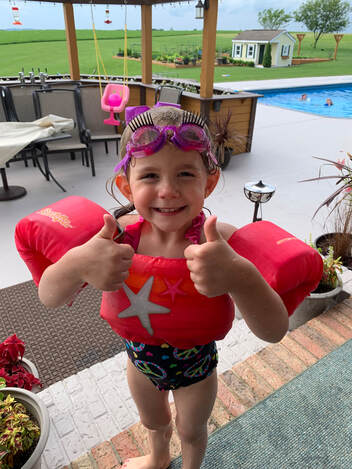 Consider what a smile does: it makes you happier, and broadcasts to the world that you are positive, uplifting, optimistic, and open. It is life-affirming. Translated, it tells people that you like them — that they make you happy. It can be interpreted to mean that you admire them. It says, “I am happy to see you!” Even if you are a stranger. People naturally want to mirror what you are doing so if you are smiling, they will feel the desire to smile in return. And as Dale Carnegie wrote, when you smile, in and of itself, it can make you happy. While conducting research on the physiology of facial expressions in the mid-19th century, French neurologist Guillaume Duchenne identified two distinct types of smiles — one with the facial muscles and one involving the eyes. Since then, researchers have discovered that if you smile with your eyes, including crinkling of the corners sometimes called, your crow’s feet, it represents more of an authentic, joyful smile. And if you smile with just your mouth — artificially raising the corners of your mouth muscles — it can be interpreted as a “fake smile.” This is also sometimes called, “the Pan Am smile,” or “the Botox smile.” So if you are going to try your own Smile Experiment, remember to involve your eyes so you do not appear to be disingenuous. I started experimenting with my smile in everyday life. As I was returning from a long walk, I saw an old friend in the alley. He had recently lost his girlfriend in a suicide and he was depressed himself to the point where he wasn’t sure if he wanted to continue. As I approached him, I smiled my biggest and brightest smile. His face lit up and he returned the smile. I kept smiling. We caught up chatting about this and that. The whole time I smiled. By the end of our conversation, it seemed perhaps as though a burden had been lifted from his shoulders for at least a little while. I have talked to people about my life’s passions and dreams, and their dreams, while smiling. I make sure that when I complement people, I deliver it with a huge smile. When I am meeting friends for dinner, I smile like there is no one else in the world I’d rather see. The results have been remarkable. Not only do I feel better and happier, I think people are more willing to accommodate me, to work with me, to help me if needed. Friends seem to want to hang out with me more. Maybe they find what I’m saying to be more interesting. They want to listen to me. They want to share their truths. Smiling is incredibly easy. It’s free. It’s powerful. Try your own experiment for a few weeks and let me know how it went. And take Toni Morrison’s advice, smile when your child enters the room!!! You can watch the interview on Oprah Winfrey here. My earliest memory of being bullied happened in the first grade, a sharp pain of being excluded and made fun of by my tender-aged quartet of best friends for reasons I could not at all understand.
It cut a wound that would come back again later in high school, years after that when I was betrayed by my best friend and even as a grown woman when my close group of friends banded together, gossiping about me for a relationship choice they disagreed with. They thought I didn’t know or notice. But I did. And it hurt. I entered first grade early. Back then, you could take a test and if you passed, if you could read, you were able to start first grade as a five year old. Even though my reading skills were up to par, my social skills apparently were not; I didn’t understand the finer points of social cues. After the mean girls incident, another classmate that I didn’t know well, Jane Bulow, took pity on me. She was brave enough to show me kindness, because often that is what kindness in the face of bullies takes. Bravery. Jane Bulow really was her name, by the way. I think it is important that you know that. Jane approached me on the playground as I cried in a corner probably making a fool of myself and blubbering all alone. I really tried to hide my pain. Jane asked me if I was okay. I lied and said, “Yes, I’m okay” and that I was only crying “because I had a sore lip”. Jane was not fooled. She knew exactly why I was there standing alone in the corner by the brick walls and knew how I was feeling. She told me that those girls were awful and I did nothing wrong and then asked if I would like to play with her on the swings. I was immensely relieved as Jane threw me that life preserver. In hindsight, she was bookish, industrious and reflective. I was fun-loving, silly and playful. She seemed so much older than all the rest of us and not someone I would normally befriend. She was a child that some might identify as having an old soul. It’s amazing though how an act of kindness will engender loyalty from the recipient of that kindness. It is powerful. I ended up developing a close friendship with Jane. I learned to appreciate her studiousness. She didn’t buy into the whole ruse of the importance of popularity. She saw right through those girls too and her kindness made me realize that humanity, consideration and sympathy were character traits that I wanted to embody. I wanted to be like her. She showed me a better way and I reflect on her kindness often with everlasting gratitude. According to GreatSchools.org: Without any education or support from adults, the vast majority of children will not take any action if they are bystanders to the act of bullying. “The proportion of children who will spontaneously intervene is about one in five,” says Ken Rigby, adjunct professor of education at the University of South Australia and the author of many books on bullying. “Children on the whole feel bullying is wrong and unfair, and most want to intervene, but there are all sorts of reasons why they don’t.” The first step in empowering bystanders to act is to help them see that their peers also feel bullying is wrong. “Once they recognize that many of their friends want them to intervene, they are more likely to,” says Rigby. Another imperative in the fight against bullying is to teach children that intervening can make a positive difference. Indeed, if fellow students will intervene, it can reduce bullying more effectively than anything. “Most bullies bully because they want to impress people and they like an audience. So if the audience is booing instead of clapping, they realize they’re losing their audience,” says Rigby. In an age when bullying can lead to far more serious consequences than hurt feelings — like Columbine High School, many adults are starting to take notice. But not nearly enough. The long-term effects from bullying are grim and the societal negative consequences are staggering. But even schoolyard bullying hurts, gossip hurts, being excluded hurts, no matter what your age. Read more about anti-bullying programs here. Looking back, I came up with a hundred or so things I could have done in that situation, but as a young child, I was paralyzed. Ultimately, it is so hard to stand up to bullies and it takes bravery, the kind of courage that sometimes can only come from an old soul, from a child who shows more wisdom than the adults that surround her. Childhood friends come and go. What happened to my dear friend Jane? That summer, she was riding her horse when a disturbed hornet stung it. The horse bucked, as they do sometimes in such situations, and threw Jane off. In an age before we routinely wore helmets, she hit her head on a rock and was killed instantly. My mom took me to her funeral. Jane’s mom pulled us aside and confided that her husband went right out into the field and shot and killed the horse. I was mortified. The horse. A tragedy all the way around. When we got back to our car in the parking lot of the funeral home my mom put her head in her hands and sobbed. I found myself comforting her. I asked her why she was so sad. I felt like she had no right to be more upset than me. Jane was my friend. She didn’t even know Jane. I should be the one sobbing in my hands. And my mom finally explained why she was crying and of course, it was something I could never understand until I had children of my own. Losing a child is a tragedy so profound that no one can really begin to comprehend unless they have a child. And even then… Mom didn’t say this to me in a condescending way. It was in a loving way, and that was how she, in that moment, and in many thousands of moments since, showed her unconditional love and kindness to me. My mother is an old soul, too. For my whole life, I have always stood up for and rooted for the underdog, especially in sports. Any time I have seen some injustice happening, I have stepped in, even sometimes at my own peril. When my own children were beset by an occasional bully I immediately inserted myself into the situation, even at the risk of them being angry with me. And as for Jane, I think of her often. #janebulowlives #kindness #stopbullying #oldsouls Photo Credit: Jelleke Vanooteghem Never underestimate the play value of a mud pit for your children, and the relative ease for you to provide one. It was the summer of 1993. I left Ohio the day after a tornado swept through, narrowly missing our home and our broken family inside it. I moved to Los Angeles with my very young children in what became the beginning of a long and painful divorce saga. Money was tight and the price of renting a house in Los Angeles, even back then, seemed outrageous. What was I getting myself into? I was finally able to secure a bungalow near Westwood with three bedrooms and a small, fenced-in backyard. My first twelve months in California were remarkably difficult, punctuated by the Malibu fires in October and the Northridge Earthquake that January. After my third force majeure, tornado, fire, earthquake, I thought maybe God had it out for me. Fitting, I thought, after I had left my husband in the worst possible way. I didn’t have a whole lot of toys for the kids and even less budget to buy more. What I did have was a patch of dirt and a hose, balls, little shovels and buckets, and one modest, plastic playhouse. Unbeknownst to me one day, the children (four ranging from 3 years to almost six years-old in case you were wondering) figured out how to turn on the faucet and were squirting each other with the hose — good fun — I thought since it was sweltering. Soon, that little game devolved into them directing the hose to the dirt patch until it was a frothy pit of mud. Fun! Leave it to my kids to invent a new way to play, covered with mud from head to toe. I didn’t really care too awful much, and when it was time to come in, I just lined them up and sprayed them clean with the hose. We all went inside and their clothes went right into the washing machine. They took a proper bath and got ready for dinner. 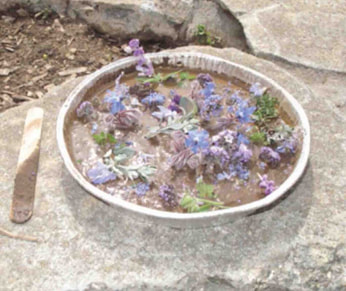 Playing in the mud became a repeat performance over the summer. I bought them tin pie pans and we made mud pies that we decorated with the plentiful flowers growing all around us — yellow hibiscus, fuchsia bougainvillea, and sweet-smelling plumeria. These flowers were not found in Ohio. They also made up games, dug for worms, filled up sand buckets and dangit, they were pretty sure they were going to make it to China if they kept digging. ,Many years later, after I had started my company teaching schoolchildren to garden, I started noticing research about the benefits for children to play or dig in the dirt. What I learned is that there is a microscopic bacteria in dirt called Mycobacterium Vaccae, which stimulates the immune systems and has all kind of other benefits like soothing children, relieving stress and helping them to relax. It even helps ease allergies and ADHD symptoms. Heck it has the same benefits for grownups too. There has been a lot of research on this and my take on it is that digging in the dirt is hardwired into our DNA to be healthy for us. By most estimates, we humans have relied on growing our own food for the last 12,000 years. In a paper written for the USDA, the Agricultural Economist, Jayson Luck, says that at the turn of the last century, just under 40 percent of the total US population lived on farms, and 60 percent lived in rural areas. Today, the respective figures are only about 1 percent and 20 percent. What does this tell us? At one point in time, we were an agrarian society and our immune systems were attuned to that, even developed around that. And now, we sit behind a desk all day. The most physical work we do is an hour at the gym. And you can buy a whole chicken at the grocery store for $6.00 rendering raising chickens and slaughtering them (not an easy task I can assure you), a losing proposition. I grew up on a farm, and since my mom is getting older and my dad has long ago passed away, she only keeps a few chickens for the eggs. She gave my three brothers and me five acres to build a house. While I live in Los Angeles, my three brothers built their houses and live on the farm along with various nieces and nephews in a sort of wonderful Kibbutz-type situation. When my mom’s chickens got old and stopped laying eggs, she didn’t know what to do with them. In a perfect display of who my brothers are, this was their advice: My youngest brother: I’ll shoot them and you can pull out their feathers. Then we can freeze them and eat them later. My oldest brother: Don’t do that. It’s too much work! You can buy a whole chicken in the grocery store for $6.00. I’ll shoot them and you can bury them behind the chicken coop. My middle brother: Don’t shoot them mom. I’ll take them. And that’s exactly what happened. They lived out their remaining days roaming around and happily pecking in the fields for grain and bugs. 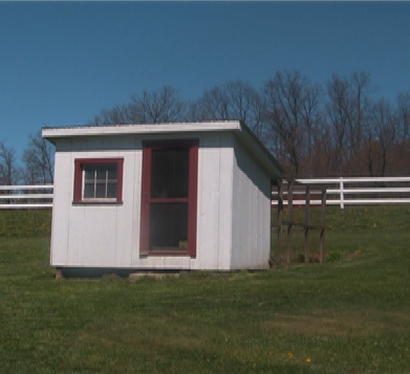 When I was growing up I helped plant the garden, weed, harvest, bale hay, clean stalls, ride horses, feed animals, and all sorts of other chores. I never had one allergy. I could bathe in a field of pollen. When I moved to the city, I developed allergies and asthma. My mom still laughs at me because I spend money to go to a gym to stay fit, when I could just work on the farm and never need to go to a gym again. My suggestion? Garden with your kids. Let them dig in the soil. If you don’t have a backyard, take them to a park. Let them roll around in the fields. Make mud pies! Even if you live in an apartment you can buy a bag of soil and a couple pots. Give your child a shovel and let them fill up pots with soil. Who cares if they make a mess? You can clean it up later. When I work with school kids it always amazes me how much they love digging in the dirt. And if you’re lucky enough to have a backyard, carve out a mud pit. Your kids will thank you later. Mine did. What was your or your child's favorite play area? Photo Credit: Seth Macey I measured 31 activities over a two month period and then averaged my weekdays. The results on where I spent my time were shocking. Neuroscientists have been studying time perception and its fluidity. They used to imagine a stopwatch in our brains that gives us a concept of the length of time spent on something. But, more recently they have found several areas in the brain that are responsible for time and our internal timekeeping. However, time is fluid and our estimates of it are not always accurate. There is even a disorder called, Dyschronometria, in which an individual cannot correctly estimate the amount of time that has passed. I’ve read a plethora of articles about improving your productivity by spending less time on certain things and more time on other things, and honestly, it doesn’t mean anything if you don’t really see where you are wasting time. And your time suck probably isn’t where you think it is unless you observe and measure. A while back, I started a Series on Medium called: The Secrets of the Universe. How You Can Use Quantum Physics to Immediately Improve Your Life. The first installment was titled, What Is The Most Powerful Tool You Can Access? And it was all about the observer effect: Measuring things changes them. Information collection can be the single most powerful tool to change your life. Want to get your financial life into shape? Measure everything you spend your money on. Simply by virtue of the fact that you are measuring it … changes it. I gave a brief example of how I kept track of everything I ate to lose ten pounds, and it worked remarkably well. My surprise was not that I could do it, or that this method would help me, but that by the simple act of observing, measuring and tracking everything I ate, caused me to eat less. It was almost like I didn’t want to disappoint myself. After my trial run with losing ten pounds, I thought, if it worked so well with that, why not observe and measure how I spend my time, because I want to be more efficient and thus more productive. This article is a follow up report with my progress and observations over the last two months. I used the app I recommended in my article, ATracker, set up categories of Health, Work and Personal and then broke those three areas down into different activities. I tried not to get too granular but yet, I wanted to get enough information that I could come up with realistic ideas on how to cut back on things I’m spending too much time on and spend more time on the things I should be spending more time on. Not unsurprisingly, there were a lot of surprises! Before I launch into those, I would say to you, don’t make decisions based on what you think you’re spending your time on. Measure it over a period of time. I did two months and I averaged the results for weekdays because this study is mostly about work for me. ATracker (and I’m sure there are others — this is just the app I used) is really flexible and simple. You have a lot of leeway to set up things however you want and the timer is an easy stop and start button, and if you forget, it is easy to go back and reconstruct. For example, if you are working on writing and switch over to bookkeeping and forget to press stop for writing and start for bookkeeping, you can easily go back and change that based on your best recollection. You can also export your data in a csv file which can then be sorted to analyze. Overall, it took effort, but the whole study did not take too much time in and of itself. Here is my analysis: The Good, The Bad, and The Surprising
You may notice that the total time is more than 24 hours, but that is because I am multi-tasking; Like walking my dog, Pietro, practicing Dutch, exercising, and listen to audiobooks (Reading) at the same time. That adds about two hours to my day which is great.  To increase my productivity, I tried to focus on what I called my, “time sucks” — things that seemed to use so much of my time. Broad stroke, I am spending more than 75% of my time in each category on just a handful of activities. I spend more time sleeping than any other activity — that old saying, “You can sleep when you’re dead,” comes to mind, but I believe we all need eight hours a day to function, so no time savings there. How can I be more efficient without sacrificing my health? There are only 24 hours in a day after all. I also don’t want to sacrifice the things I cherish most like my loved ones, exercise, and learning foreign languages. Clearly, though, I need to spend more time on Bloomers Island, Real Estate, and Writing, and less time on Watching News, Housework, Cooking/Eating, Morning Routine, and Exercise to bring my dreams to life. How do I do that? By becoming more efficient. Here’s my list of ideas: 1. Hire a housekeeper even if it’s just twice a month, to help with housekeeping. The time I spend on that (mostly weekends), I can use to write. 2. Grocery shop every other week instead of once a week. Explore grocery delivery services. Load up once a month on dry good staples like coffee, paper towels, etc. 3. Eat out more and implement meal prep on Sundays. 4. Every meal doesn’t have to be made from scratch. Utilize some shortcuts like buy a jar of minced garlic instead of mincing my own garlic. 5. Rinse dishes right after eating to eliminate time-consuming cleanup. 6. Develop more intense workouts in the morning to reduce time, e.g. run for an hour instead of walking for two hours. 7. Watch less T.V. and spend that time writing. Carve out an hour each morning for writing. 8. Be more focused — finish my task instead of jumping from one task to another and then back again — because that takes extra time. Honor transitions between right brain and left brain activities for improved focus. (Time tracking actually helps me do that.) 9. Implement the Pomodoro Technique: I’ve experimented with this and it works better than I expected. I spend 25 intense minutes working on a particular thing, and then I take a five minute break. 10. I can definitely get moving faster and better in the morning. Do I really need a half hour to drink my coffee and rub the sleep out of my eyes? I don’t think so. My conclusion after seeing the results of my study is that most of us believe we are spending more time on the things we dislike than we really are, and less on things we love doing or should be doing to bring our dreams to life. Our perception of time is distorted. And you may think you know what you are spending your time on but you may not. I suggest spend a couple months measuring it (observing) and see if your perception changes. After just the first couple weeks of tracking my time I saw that I was only spending an average of three hours a work day on Bloomers Island. I was shocked. That was not nearly enough! I made an immediate effort to increase that and it went to four hours. The simple act of observing, changed it. Accept my challenge in trying this for a couple months. Let me know what your surprises are. |
All images and designs copyright © 2008-2020 Cynthia Wylie. All Rights Reserved. Contact for licensing opportunities.





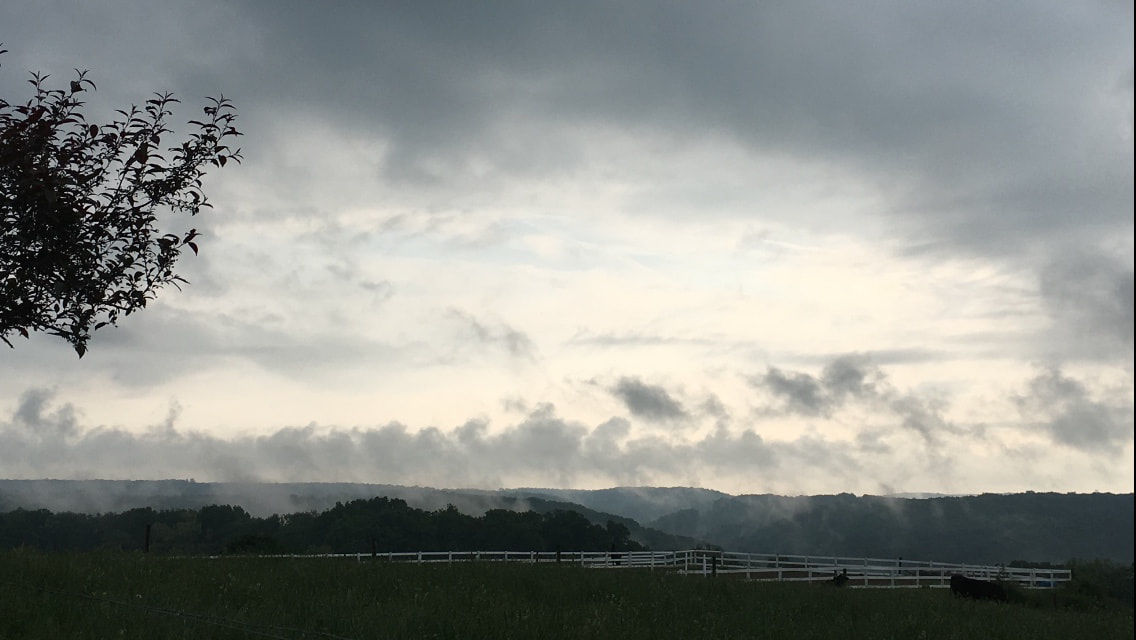
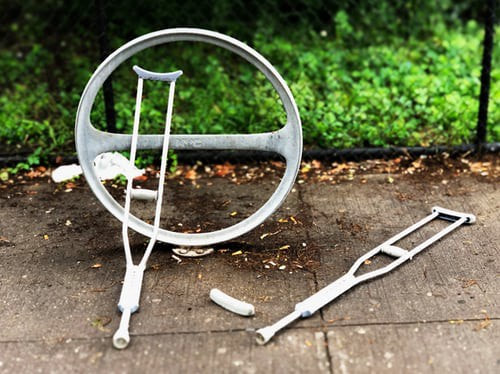

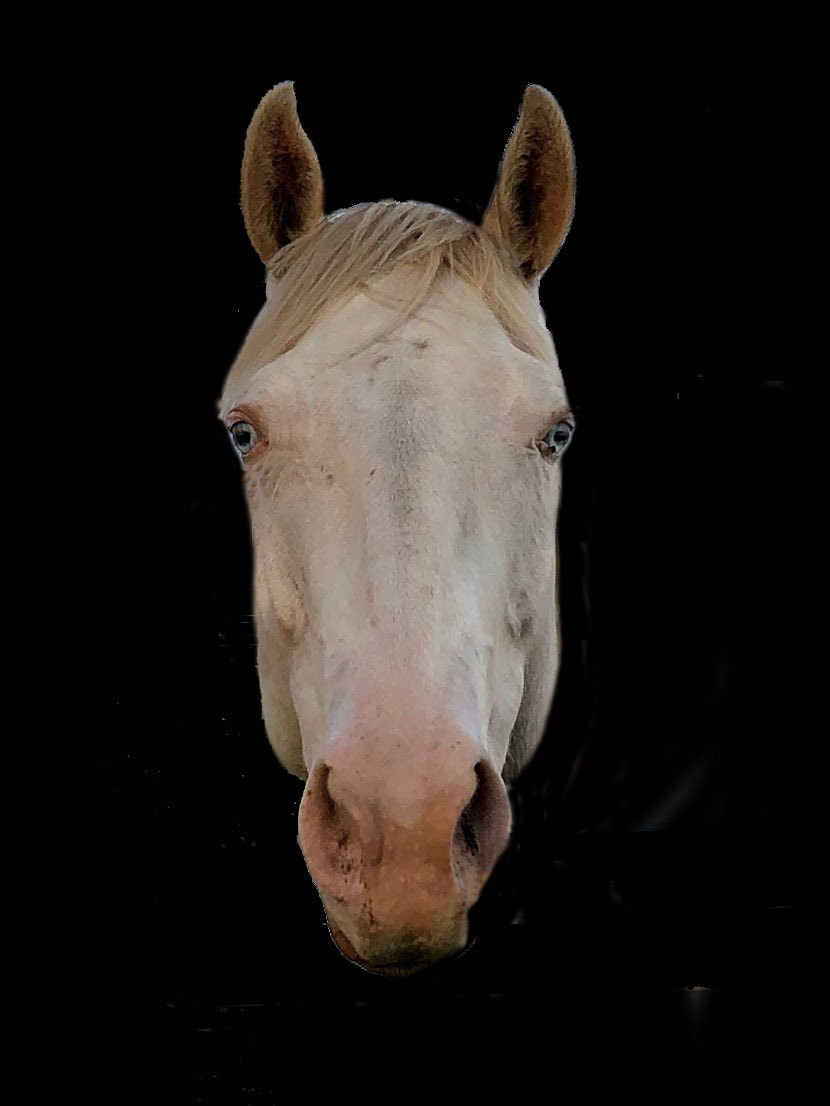
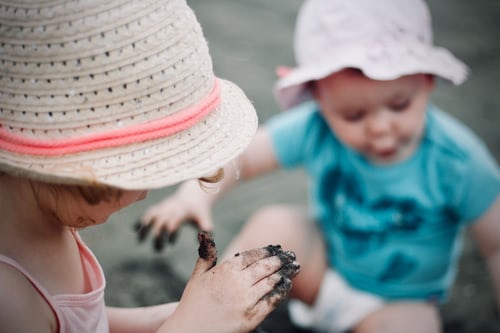

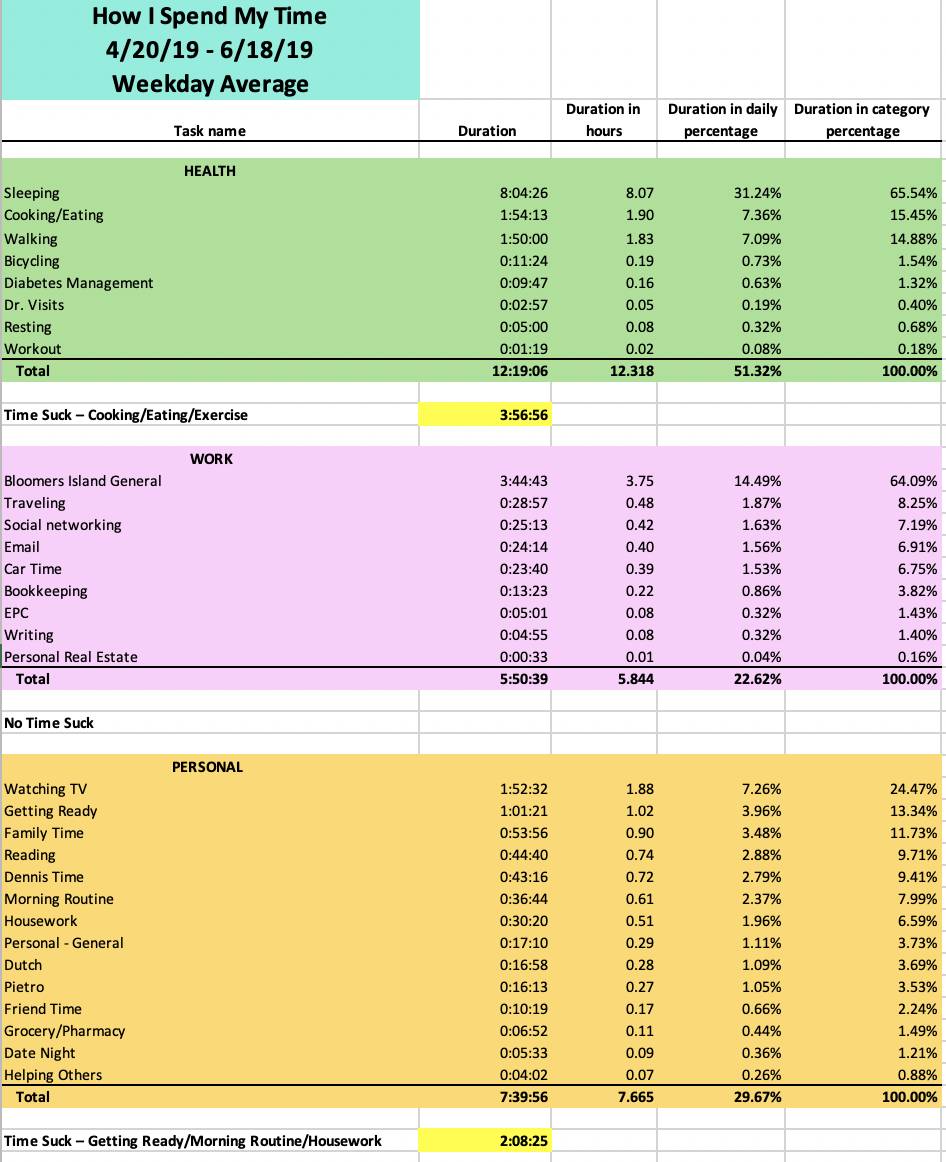
 RSS Feed
RSS Feed








